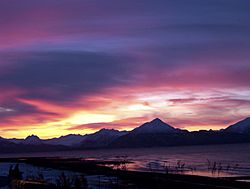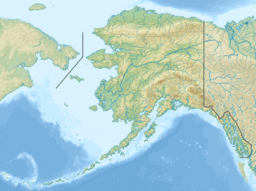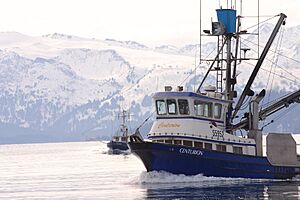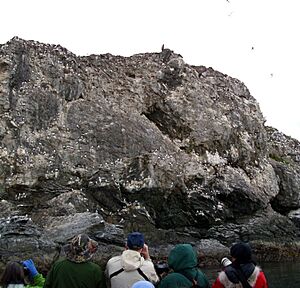Kachemak Bay facts for kids
Quick facts for kids Kachemak Bay |
|
|---|---|

Kachemak Bay at sunrise
|
|
| Location | Kenai Peninsula, Alaska |
| Coordinates | 59°36′33″N 151°20′51″W / 59.60917°N 151.34750°W |
| Type | Bay |
| Native name | Tika Kaq' (Tanaina) |
| Primary inflows | Fox River, Sheep River, Grewingk River, Wosnesenski River, Seldovia River, Bradley River, Portlock River, Martin River, English Bay River |
| Basin countries | United States |
| Max. length | 40 mi (64 km) |
| Max. width | 6 mi (9.7 km) |
| Average depth | 150 ft (46 m) |
| Max. depth | 576 ft (176 m) |
| Islands | Chugachik Island, Bear Island, Ismailof Island, San Juan Island, Herring Islands, Cohen Island, Yukon Island, Hesketh Island, Grass Island, Powder Island, Gull Island, Mermaid Island |
| Sections/sub-basins | Bear Cove, Mallard Bay, Aurora Lagoon, Halibut Cove, Halibut Cove Lagoon, Peterson Bay, China Poot Bay, Neptune Bay, Sadie Cove, Eldred Passage, Tutka Bay, Little Tutka Bay, Jakolof Bay, Kasitsna Bay, Seldovia Bay, Port Graham, English Bay |
| Settlements | Homer, Halibut Cove, Seldovia, Nanwalek, Port Graham, Kachemak City, Fox River Voznesenka, Kachemak Selo, Razdolna |
Kachemak Bay is a beautiful bay in Alaska, located on the southwest side of the Kenai Peninsula. It is about 40 miles (64 km) long and is an arm of Cook Inlet. Many towns and villages are found along its shores. These include Homer, Halibut Cove, and Seldovia.
The native Dena'ina people call the bay Tika Kaq’. Some people believe the name "Kachemak" means "Smokey Bay." This name might come from an old Alutiiq word. It could describe how smoke from burning coal seams used to fill the bay.
Contents
Exploring Kachemak Bay's Unique Features
Kachemak Bay is famous for its natural beauty and important wildlife. It is home to Alaska's very first state park. The bay also has a special research area for studying estuaries.
Kachemak Bay State Park
Kachemak Bay is home to Kachemak Bay State Park. This is Alaska's only state wilderness park. It was the first state park ever created in Alaska. Most of the park cannot be reached by road. Visitors usually arrive by airplane or boat. This helps keep the park wild and natural.
Kachemak Bay National Estuarine Research Reserve
The bay also hosts the Kachemak Bay National Estuarine Research Reserve. This is the largest reserve in the entire National Estuarine Research Reserve System. It is a very active place for scientists to do research. Many educational programs are also held here.
Why Kachemak Bay is Full of Life
Kachemak Bay has a lot of biological activity. This means many different plants and animals thrive here. Water currents help keep tiny shellfish larvae and important nutrients inside the bay. Surface waters push nutrients out, but ocean currents push them back in. This creates a very rich environment for all kinds of life.
Amazing Animals of Kachemak Bay
Both fish and shellfish are plentiful in the bay all year long. Many waterfowl and shorebirds visit the bay during most seasons. Waterbirds and marine mammals stay in the bay throughout the year. You can often see otters, seals, porpoise, and whales.
The bay is a winter home for 90% of the seabird and waterfowl populations from Lower Cook Inlet. Land mammals are also often seen when the weather is warmer. It is common to spot moose, coyote, and bears.
Understanding the Tides in Kachemak Bay
The tides in Kachemak Bay are very strong. The average difference between high and low tide is about 15.53 feet (4.73 meters). The biggest difference ever recorded was 31.72 feet (9.67 meters). This was measured at the Seldovia Tide Station.
The highest tide ever recorded was 25.25 feet (7.70 meters) above the average low water mark. This happened on November 15, 1966. The lowest tide ever recorded was 6.4 feet (1.95 meters) below the average low water mark. This occurred on April 27, 2002.





